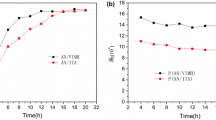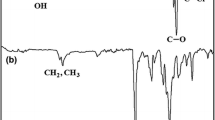Abstract
N-(4-iodo-1,3-diphenylbutyl) acrylamide (NIAM) is a potential hydrophobic monomer for preparation of hydrophobically modified polyacrylamide largely used for enhanced oil recovery. Moreover, it has an iodine group as substitute allowing further modification reactions. This monomer was synthesized via Ritter reaction as described in the literature and characterized by nuclear magnetic resonance (NMR), thermogravimetric analysis (TGA) and differential scanning calorimetry (DSC). DSC analysis of monomer showed two endothermic peaks referring to the melting points of a mixture of diastereoisomers. Conventional radical homopolymerization of NIAM was investigated, and the polymer was characterized by NMR, TGA, DSC and size-exclusion chromatography. The polymerization was successfully performed only in the presence of large amounts of radical initiator 2,2′-azobis(2-methylpropionitrile) (AIBN) suggesting an iodine transfer polymerization mechanism. The polymer showed low degree of polymerization, dispersity lower than 1.1 and glass transition temperature of 19.5 °C.










Similar content being viewed by others
References
Yuan R, Li Y, Li C, Fang H, Wang W (2013) Study about how the metal cationic ions affect the properties of partially hydrolyzed hydrophobically modified polyacrylamide (HMHPAM) in aqueous solution. Colloid Surf A 434:16–24. https://doi.org/10.1016/j.colsurfa.2013.05.036
Feng Y, Billon L, Grassl B, Khoukh A, Françóis J (2002) Hydrophobically associating polyacrylamides and their partially hydrolyzed derivatives prepared by post-modification. Polymer 43:2055–2064. https://doi.org/10.1016/S0032-3861(01)00774-1
Zhu Z, Jian O, Paillet S, Desbrières J, Grassl B (2007) Hydrophobically modified associating polyacrylamide (HAPAM) synthesized by micellar copolymerization at high monomer concentration. Eur Polym J 43(3):824–834. https://doi.org/10.1016/j.eurpolymj.2006.12.016
Hourdet D, Ducouret G, Varghese S, Badiger MV, Wadgaonkar PP (2013) Thermodynamic behavior of hydrophobically modified polyacrylamide containing random distribution of hydrophobes: experimental and theoretical investigations. Polymer 54:2676–2689. https://doi.org/10.1016/j.polymer.2013.03.039
Viken AL, Skauge T, Svendsen PE, Time PA, Spildo K (2018) Thermothickening and salinity tolerant hydrophobically modified polyacrylamides for polymer flooding. Energy Fuels 32(10):10421–10427. https://doi.org/10.1021/acs.energyfuels.8b02026
Maia AMS, Villetti MA, Vidal RRL, Borsali R, Balaban RC (2011) Solution properties of a hydrophobically associating polyacrylamide and its polyelectrolyte derivatives determined by light scattering, small angle X-ray scattering and viscometry. J Braz Chem Soc 22(3):489–500. https://doi.org/10.1590/S0103-50532011000300012
Ceniceros ACL, Vallejo CR, Regalado EJJ (2007) Synthesis, characterization and rheological properties of three different associative polymers obtained by micellar polymerization. Polym Bull 58:425–433. https://doi.org/10.1007/s00289-006-0675-3
Branham KD, Davis DL (1994) Water-soluble polymers: 59. Investigation of the effects of polymer microstructure on the associative behaviour of amphiphilic terpolymers of acrylamide, acrylic acid and N-[(4-decyl)phenyl]acrylamide. Polymer 35(20):4429–4436. https://doi.org/10.1016/0032-3861(94)90103-1
Abu-Sharkh BF, Yahaya GO, Ali SA, Hamad EZ, Abu-Reesh IM (2003) Viscosity behavior and surface and interfacial activities of hydrophobically modified water-soluble acrylamide/N-phenyl acrylamide block copolymers. J Appl Polym Sci 89:2290–2300. https://doi.org/10.1002/app.12198
Volpert E, Selb J, Candau F (1996) Influence of the hydrophobe structure on composition, microstructure, and rheology in associating polyacrylamides prepared by micellar copolymerization. Macromolecules 29:1452–1463. https://doi.org/10.1021/ma951178m
Khakpour H, Abdollahi M (2016) Synthesis, characterization, rheological properties and hydrophobic nano-association of acrylamide/styrene and acrylamide/sodium styrene sulfonate/styrene co- and terpolymers. J Polym Res 23:168. https://doi.org/10.1007/s10965-016-1064-8
Kang W, Zhua Z, Yang H, Tian S, Wang P, Zhang X, Ali Lashari Z (2019) Study on the association behavior of a hydrophobically modified polyacrylamide in aqueous solution based on host-guest inclusion. J Mol Liq 275:544–553. https://doi.org/10.1016/j.molliq.2018.11.063
Huang J-M, Ye Z-J, Chen D-S, Zhu H (2012) Iodine mediated/Brønsted acid-catalyzed dimerization of vinylarenes: a tandem reaction through Ritter trapping to produce N-(4-iodo-1,3-diarylbutyl) acetamides. Org Biomol Chem 10(18):3610–3612. https://doi.org/10.1039/C2OB25142F
Jiang D, He T, Ma L, Wang Z (2014) Recent developments in Ritter reaction. RSC Adv 4:64936–64946. https://doi.org/10.1039/C4RA10784E
Hunter CA, Sanders JKM (1990) The nature of π–π interactions. J Am Chem Soc 112(14):5525–5534. https://doi.org/10.1021/ja00170a016
Carey FA, Sundberg RJ (2007) Advanced organic chemistry part A: structure and mechanisms. Springer, New York
David G, Boyer C, Tonnar J, Ameduri B, Lacroix-Desmazes P, Boutevin B (2006) Use of iodocompounds in radical polymerization. Chem Rev 106(9):3936–3962. https://doi.org/10.1021/cr0509612
Odian G (2004) Principles of polymerization. Wiley, New York
Azemar F, Rodrigues DG, Robin JJ, Monge S (2016) Synthesis and self-assembly of carbamoylmethylphosphonate acrylamide-based diblock copolymers: new valuable thermosensitive materials. Dalton Trans 45:1881–1885. https://doi.org/10.1039/C5DT03289J
Zhang L, Zhu Z, Azhar U, Ma J, Zhang Y, Zong C, Zhang S (2018) Synthesis of well-defined PVDF-based amphiphilic block copolymer via iodine transfer polymerization for antifouling membrane application. Ind Eng Chem Res 57:8689–8697. https://doi.org/10.1021/acs.iecr.8b00533
Acknowledgements
The authors acknowledge the financial support by PETROBRAS S.A., Dr. Alexsandro Dallegrave for the UHPLC-QTOF-MS measurements, and Chun T-H. thanks the scholarship financial support given by Coordenação de Aperfeiçoamento de Pessoal de Nível Superior—Brasil (CAPES)—Finance Code 001.
Author information
Authors and Affiliations
Corresponding author
Additional information
Publisher's Note
Springer Nature remains neutral with regard to jurisdictional claims in published maps and institutional affiliations.
Electronic supplementary material
Below is the link to the electronic supplementary material.
Rights and permissions
About this article
Cite this article
Huang, C.T., de Oliveira, L.A., de Carvalho Peres, A.C. et al. Studies of radical homopolymerization of N-(4-iodo-1,3-diphenylbutyl) acrylamide. Polym. Bull. 77, 4523–4535 (2020). https://doi.org/10.1007/s00289-019-02982-x
Received:
Revised:
Accepted:
Published:
Issue Date:
DOI: https://doi.org/10.1007/s00289-019-02982-x




